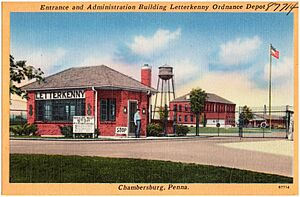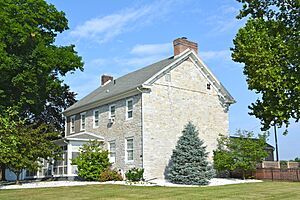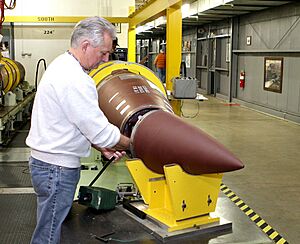Letterkenny Army Depot facts for kids
Quick facts for kids Letterkenny Army Depot (formerly, Letterkenny Ordnance Depot) |
|
|---|---|
| Part of U.S. Army Aviation and Missile Command (AMCOM) | |
| Letterkenny Township, Pennsylvania | |
 |
|
| Type | Maintenance, modification, storage, and demilitarization operations of tactical missiles and ammunition |
| Site information | |
| Owner | United States Army |
| Condition | Operational |
| Site history | |
| Built | 1942 |
Letterkenny Army Depot (originally called Letterkenny Ordnance Depot) is a very important place for the United States Army. It was started in early 1942. This depot helps maintain, change, store, and safely get rid of military items. These items include tactical missiles and ammunition.
The depot is part of the U.S. Army Aviation and Missile Command (AMCOM). It is located mostly in Letterkenny Township. It also extends into Greene Township and Hamilton Township. All these places are in Franklin County, Pennsylvania, near Chambersburg. The depot covers almost 18,000 acres (71 square kilometers). It is the biggest employer in Franklin County. It also adds a lot of money to the local economy each year.
Letterkenny is special because it can repair many different missile systems. This includes the MIM-104 PATRIOT missile. It also fixes the equipment that helps the PATRIOT missile work. More recently, Letterkenny started working on other things. These include fixing tactical wheeled vehicles like HMMWVs. They also work on cranes and Mobile Kitchen Trailers. In 2007, during the Iraq conflict, Letterkenny helped build new Mine Resistant Ambush Protected (MRAP) armored vehicles. In 2010, it became the main place for fixing Route Clearance Vehicles for the Department of Defense.
Contents
History of Letterkenny Army Depot
Early Years: 1940s to 1960s
In 1941, the U.S. Department of War chose Letterkenny to be one of twelve new supply depots. On December 18, 1941, the Secretary of War, Henry L. Stimson, ordered the land to be bought. The depot's job was to store and ship ammunition, trucks, and other supplies. Construction started in January 1942 and finished in April 1942.
The government also bought the James Finley House in 1942. This house became the home for the commanding officer. In July 1942, the depot started hiring civilian workers.
The first train full of ammunition arrived in late 1942. During World War II, over three million tons of supplies were moved. From 1943, a weekly newsletter called the "Kenny Letter" kept workers informed. In August 1945, a special "V-J edition" celebrated the end of the war. The depot also had a civilian baseball team. They played against other local teams in the summers of 1943 and 1944.
After the war, a lot of ammunition came back from overseas. Some of it had to be destroyed. During the Korean War, Letterkenny's work increased. The number of workers grew to 6,500. In the 1950s, the depot started working on new technologies. This included electronics and guided missile maintenance. Workers began fixing Project Nike missile parts in 1953.
On July 1, 1954, Letterkenny Ordnance Depot became a permanent military installation. In August 1962, it was renamed Letterkenny Army Depot. This happened under the U.S. Army Materiel Command (AMC). During the war in Vietnam, Letterkenny's work grew even more. Its maintenance division became very busy. It had 1,400 workers fixing artillery, combat vehicles, and guided missiles. New machines and updated facilities were also added. In 1964, the 28th Ordnance Detachment moved to Letterkenny. They helped dispose of explosive items like bombs and rockets. They also helped police with explosives.
Growth and Modernization: 1970s to 1990s
In the 1970s, Letterkenny took command of the Savanna Army Depot Activity in Illinois. The U.S. Army Depot System Command (DESCOM) was also created and based there. DESCOM stayed at the depot until 1995. In 1974, Letterkenny started maintaining the Air Tow Missile. It also stored war reserve stock of fuel and chemicals. By the late 1970s, Letterkenny was one of five places in the U.S. to use the Automated Multi-Media Exchange (AMME). This helped with better communication. At that time, Letterkenny was the largest military base in Pennsylvania. It had over 5,400 workers.
During the 1980s and early 1990s, the depot continued to grow. New buildings were built, and old ones were updated. Its main jobs were supply, maintenance, and ammunition. Letterkenny's work with the Paladin (M109 howitzer), PATRIOT, and HAWK missiles earned it a special title. It was called a Center for Technical Excellence. Its abilities also expanded to include the AIM-7 Sparrow and the improved AIM-9 Sidewinder missiles.
In 1990, Letterkenny was chosen to store all weapons captured during the invasion of Panama (Operation Just Cause). Two years later, the depot became the main center for all Tactical Missile Systems in the Army, Navy, Air Force, and Marines. This meant supporting 21 new missile systems. Letterkenny became known as "the well renowned depot for air defense and missile maintenance." In the same year, the depot's supply mission moved to New Cumberland, Pennsylvania. However, a smaller supply group was reestablished at Letterkenny by 2001.
In 1994, Letterkenny worked with United Defense to build the Paladin. They completed 950 of them in five years. After the Cold War, the U.S. government started the 1995 Base Realignment and Closure Commission (BRAC). This moved Letterkenny's artillery work to Anniston Army Depot. BRAC also ordered nearly 1,500 acres of land to be given back to the community. By 2014, most of this land had been returned.
In late 1999, the depot changed from the U.S. Army Industrial Operations Command (IOC) to the U.S. Army Aviation and Missile Command.
New Century: 2000s and 2010s
In 2001, Letterkenny was recognized as a Center of Industrial and Technical Excellence (CITE). This was for Air Defense and Tactical Missile Ground Support Equipment. In 2005, it also became the CITE for Mobile Electric Power Generation Equipment.
After the terrorist attacks of September 11, 2001, Letterkenny helped with the Global War on Terrorism. It fixed Ground Mobility Vehicles (GMVs) and High-Mobility Multipurpose Wheeled Vehicles (HMMWVs). It also updated PATRIOT Missiles.
Using smart manufacturing ideas, Letterkenny changed its large vehicle building. It became a flexible factory floor. Each work area had the same tools. This helped them meet new challenges. Soon after, the depot started working with private companies. They shared skills and special abilities.
In 2005, Letterkenny won the silver Shingo Prize for Excellence in Manufacturing for the PATRIOT Missile Launcher. This was the first time an Army depot won this award. Letterkenny would go on to win eight Shingo awards in total. These awards were for work on HMMWVs, Generators, PATRIOT Systems, and other equipment. In the same year, BRAC named Letterkenny as the best for Tactical Wheeled Vehicles.
During the 2000s, the depot focused on cranes, generators, HMMWVs, and PATRIOT Missile updates. They also worked on mine protected vehicles.
In the 2010s, Letterkenny worked with private companies to make missiles. They also improved the High Mobility Artillery Rocket System (HIMARS). This included special tools, training, and testing.
A main focus became making Route Clearance Vehicles (RCV). In 2010, Letterkenny was named the main place for fixing RCVs. This included vehicles like the Buffalo/MPCV and the Husky.
In December 2010, Letterkenny finished fixing over 20,000 HMMWVs. After this, they changed their main assembly line. They started working on PATRIOT Prime Movers. This included fixing trailers and large trucks.
In 2012, Letterkenny was recognized as a CITE for RCV and PATRIOT Missile Recertification.
Explosion Incident
On July 19, 2018, an explosion happened at the depot. Two civilian employees died, and two others were injured.
Environmental Cleanup Efforts
In the 1960s, people started to worry about pollution at the depot. In 1969, they began to reduce air pollution. By 1972, all heating systems that burned coal were changed to use fuel oil. In 1983, the water underground at the depot was found to be polluted. This was from chemicals called volatile organic compounds (VOC). In 1984, more polluted areas were found. Some old waste pits had caused the pollution to spread into the groundwater. This polluted water moved off-site and affected nearby springs and water wells. The Army gave bottled water to people whose wells were affected.
On October 15, 1984, the site was suggested for the National Priorities List. This list includes the most serious hazardous waste sites that need long-term cleanup. It was added to the list on July 22, 1987. That year, 38 homes and businesses were connected to the local water supply. In 1992, three more homes were added.
In 1989, the depot installed a "pump and treat" system. This system cleans the polluted groundwater. It is still used today. Much of the pollution came from cleaning chemicals, paints, and other materials. These were stored or spilled in the 1950s and 1960s.
The depot has been recognized for its environmental work. It received awards from the Secretary of the Army in 2002, 2006, and 2009.
As of 2014, the environmental cleanup has cost the Army about $30 million. This cleanup has slowed down the return of land to the community. This land was ordered to be returned by the Base Realignment and Closure in 1995. Letterkenny has a group called the Restoration Advisory Board. It includes government and community members. They meet to talk about the cleanup and future land transfers.
Awards and Recognition
- Global War on Terrorism
- Army Superior Unit Award 2007
|



